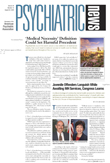Recent federal regulations have mandated that psychiatric facilities use physical restraint only when patients pose a danger to themselves or others and as a last resort.
Finding effective and safe alternatives to restraint or avoiding its use altogether is critical for inpatient psychiatric facilities. Researchers in the department of psychiatry at the University of Illinois at Chicago (UIC) described an effective training program in the July issue of the APA journal Psychiatric Services that led to a significant reduction in the use of restraint with adolescent and adult psychiatric inpatients.
The first component of the program involves teaching psychiatric inpatients to recognize what triggers their anger or aggression and strategies known as crisis-management training. The second component involves training hospital staff about factors that precipitate aggressive behaviors and nonviolent interventions for managing patient crises.
Both training components were implemented in October 2001 on the adolescent psychiatry and general adult psychiatry units at a hospital affiliated with UIC. The clinical research psychiatric unit implemented the first training component in July 2001 and the second component in October 2001.
The study was based on quarterly restraint data from the hospital's quality improvement department examined from July 2000 through December 2002.
More than 2,000 patients were treated in the general psychiatry and clinical research units of the hospital during the study period. A majority were diagnosed with schizophrenia or other psychotic disorders or mood disorders.
About 220 patients were treated in the adolescent psychiatry unit from July 2000 through 2002. Their primary diagnoses were major depression or a depressive disorder, adjustment disorder, conduct disorder, and schizophrenia or a psychotic disorder.
The adolescent patients experienced a 48 percent decrease in the restraint rate one quarter after the training occurred and a 98 percent decrease two quarters after the training, the authors stated. The rate remained low throughout the final two quarters of the year.
The general psychiatry patients experienced an 85 percent decline in the restraint rate one quarter after the training and a 99 percent decline two quarters after the training. “Once again, the rate remained low during the final two quarters of the evaluation period,” the authors commented.
The clinical research patients experienced a 51 percent decrease in the restraint rate in the quarter after they received crisis-prevention training and a 49 percent decrease in the quarter after hospital staff were trained in nonviolent interventions, the authors reported.
In the two quarters following both training components, the rate of restraint use for the clinical research patients declined by 98 percent and remained at zero for the final two quarters, the authors stated.
The training had a significant, positive effect on patients in all three units. “Staff members and patients found the procedures easy to use and expressed high satisfaction with the results,” the authors said.
A major limitation of the study was the absence of a control group. Having data on a control group would have clarified the direct effect of the intervention on reducing the restraint rate, the authors commented. In addition, the authors could not verify that the staff used crisis-management or nonviolent crisis-management interventions correctly or consistently.
“However, all new staff members were trained immediately after their hiring, and retraining was conducted annually,” they noted.
“These findings have important clinical implications and suggest areas of future research. Comprehensive staff training in crisis de-escalation techniques and nonviolent interventions should be adopted by hospitals to reduce the use of physical restraint with children and adults,” the authors concluded.
There is also a “need for more rigorous evaluation of the intervention's effectiveness and the satisfaction of staff members and patients with noncoercive alternatives to restraint.”
Psychiatric Serv 2004 55 818
